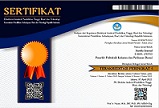POLYCULTURAL GROWTH IMPROVEMENT PERFORMANCE OF CATFISH (Clarias sp.) AND TILAPIA FISH (Oreocromis niloticus) CULTIVATED IN THE BIOFLOCK CULTIVATION SYSTEM
Abstract
The biofloc system is a solution for intensive cultivation activities. This is because in biofloc system the are heterotrophic bacteria that can reuse waste from cultured organisms so as to improve water quality. However, the biofloc system can cause high nitrite production if the dissolved oxygen concentration in the water is below the optimum value. High nitrite concentrations can cause brown nitrite, causing fish to suffocate even though the oxygen concentration in the water is sufficient. Polyculture can be a solution to reduce the concentration of biofloc so that brown nitrite can be prevented. Therefore, a research was conducted with the aim of knowing the effect of the composition of the best polyculture biota in order to produce high cultivation performance. The ratio of tilapia and catfish used included 80% catfish and 20% tilapia fish (treatment A), 70% catfish and 30% tilapia fish (treatment B), 60% catfish and 40% tilapia ( treatment C), and 100% catfish (treatment D). Maintenance is carried out for 60 days where feeding is done on a restricted basis. The results of the research carried out showed that the best FCR, ADG and SR were in treatment C with consecutive values of 1.27 ± 0.02 (FCR), 1.4 g/day (ADG) on the last maintenance day, 95.11 ± 1.02% (SR). This study shows that the performance of cultivation in biofloc systems in polyculture is better than monoculture.
Keywords
Full Text:
PDFReferences
Amri, K., & Kanna, I. 2008. Budidaya Udang Vaname. Jakarta: Gramedia Pustaka Utama.
Avnimelech, Y. 1999. Carbon/Nitrogen Ratio as a Control Element in Aquaculture Systems. Aquaculture. 176: 227–235.
Azim, M. E., & Little, D. C. 2008. The biofloc technology BFT in indoor tanks: Water quality, biofloc composition, and growth and welfare of Nile tilapia (Oreochomis niloticus). Aquaculture. 283: 29–35. https://doi.org/10.1016/j.aquaculture.2008.06.036
Bowser, P., Falls, W., Vanzandt, J., Collier, N., & Phillips, J. 1983. Methemoglobinemia in channel catfish: Methods of prevention. The Progressive Fish-Cultured. 453: 154–158.
Crab, R., Avnimelech, Y., Defoirdt, T., Bossier, P., & Verstraete, W. 2007. Nitrogen removal techniques in aquaculture for a sutainable production. Aquaculture. 270: 1–14.
De Schryver, P., Crab, R., Defoirdt, T., Boon, N., & Verstraete, W. 2008. The basics of bio-flocs technology: The added value for aquaculture. Aquaculture. 2773(4): 125–137. https://doi.org/10.1016/j.aquaculture.2008.02.019
Dewi, R. R. S. P. S., Iswanto, B., & Insan, I. 2016. Produktivitas dan profitabilitas budidaya ikan lele (Clarias gariepinus) hasil seleksi dan non-seleksi pada pemeliharaan di kolam tanah. Media Akuakultur. 111: 11–17.
[DPUB] Dirjen Produksi dan Usaha Budidaya. 2018. Budidaya Ikan Lele Sistem Bioflok. Jakarta: Dirjen Produksi dan Usaha Budidaya.
Durborow, R. M., Crosby, D. M., & Brunson, M. W. 1997. Nitrite in Fish Ponds. SRAC Publication. 462: 4.
Ekasari, J. 2009. Bioflocs Technology: Theory and Application in Intensive Aquaculture System. Jurnal Akuakultur Indonesia. 82: 117–126. https://doi.org/10.19027/jai.8.117-126
Green, B. W., & Schrader, K. K. 2015. Effect of stocking large channel catfish in a biofloc technology production system on production and incidence of common microbial off-flavor compounds. J Aquac Res Development. 63: 1–7. https://doi.org/doi:10.4172/2155-9546.1000314
Hanafiah, K. A. 2016. Rancangan Percobaan: Teori dan Aplikasi. Rajawali Pers.
Hartati, A., Wuryandari, T., & Wilandari, Y. 2013. Analisis varian dua faktor dalam rancangan pengamatan berulang repeated measures. Jurnal Gaussian. 24: 10.
LOAR, L. (2019). Pengaruh Penambahan Probiotik EM4 Dengan Dosis Yang Berbeda Pada Pakan Buatan Terhadap Laju Pertumbuhan, Sintasan dan Konversi Pakan Benih Ikan Lele Dumbo (Clarias gariepinus) (Doctoral dissertation, UNIVERSITAS BOSOWA).
Ma’ruf, I. 2016. Budidaya lele sistem bioflok solusi ketahanan pangan masyarakat perkotaan. SOCITA. 2: 82–86.
Meritha, W. W., Suprayudi, M. A., & Ekasari, J. 2018. The growth performance and resistance to salinity stress of striped catfish Pangasius sp. Juvenile in biofloc system with different feeding rates. Jurnal Akuakultur Indonesia. 172: 113–119.
Muarif, & Rosmawati. 2011. Kelangsungan hidup dan pertumbuhan benih ikan lele dumbo Clarias sp pada sistem resirkulasi dengan kepadatan berbeda. Jurnal Pertanian, 21, 36–47.
Nawangsari, T. 2013. Perbandingan berganda sesudah uji Kruskal-Wallis. Penguatan Peran Matematika Dan Pendidikan Matematika Untuk Indonesia Yang Lebih Baik, 6.
Novianty, S. I., Christnawati, & Darmawan, S. 2014. Pengaruh aplikasi novamin terhadap kekuatan geser pelekatan braket ortodontik. 54: 357–362.
Opasola, O. A., Adewoye, S. O., & Fawole, O. O. 2013. Growth Performance and Survival Rate of Clarias gariepinus Fed Lactobacillus acidophilus supplemented diets. IOSR Journal of Agriculture and Veterinary Science. 36: 45–50. https://doi.org/10.9790/2380-0364550
Penha, Jmf., & Mateus, Laf. 2007. Sustainable harvest of two large predatory catfish in the Cuiabá river basin, northern Pantanal, Brazil. Brazilian Journal of Biology. 671: 81–89. https://doi.org/10.1590/S1519-69842007000100011
Putra, Y. M. P., & Pratiwi, I. 2018. Lele Jadi Potensi Ekspor. Republika.co.id.
Rachmawati, D., & Samidjan, I. 2014. Penambahan fitase dalam pakan buatan sebagai upaya peningkatan kecernaan, laju pertumbuhan spesifik dan kelulushidupan benih ikan nila (Oreochromis niloticus). Indonesian Journal of Fisheries Science and Technology. 101: 48–55.
Setijaningsih, L., & Suryaningrum, L. H. (2015). Pemanfaatan limbah budidaya ikan lele (Clarias batrachus) untuk ikan nila (Oreochromis niloticus) dengan sistem resirkulasi. Berita Biologi, 14(3), 287-293. http://dx.doi.org/10.14203/beritabiologi.v14i3.1836
Suminto, S., Susilowati, T., Wibowo, B. A., & Chilmawati, D. 2018. Pengaruh tepung telur ayam afkir pada pakan buatan yang berprobiotik terhadap efisiensi pemanfaatan pakan, pertumbuhan dan kelulushidupan lele Dumbo (Clarias gariepinus). The effect of chicken eggs rejects powder in artificial feed with added probiotic on efficiency feed utilization, growth and survival rate of Dumbo Catfish (Clarias gariepinus). Saintek Perikanan: Indonesian Journal of Fisheries Science and Technology. 132: 111–118.
DOI: http://dx.doi.org/10.15578/aj.v5i2.11792
Refbacks
- There are currently no refbacks.
Citation
Pusat Penelitian dan Pengabdian Kepada Masyarakat
Politeknik Kelautan dan Perikanan Dumai
Jl. Wan Amir No. 1, Kel. Pangkalan Sesai, Kec. Dumai Barat, Kota Dumai
Telp/Fax: (0765) 4300443
This work is licensed under a Creative Commons Attribution-ShareAlike 4.0 International License.
View My Stats















